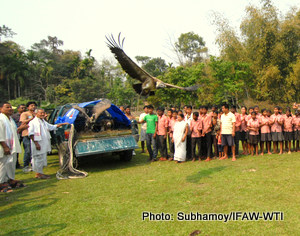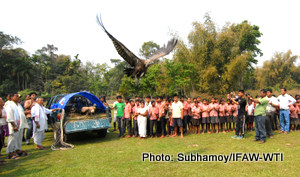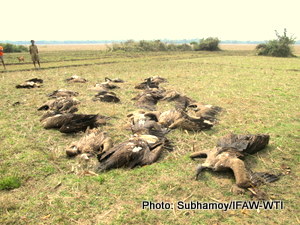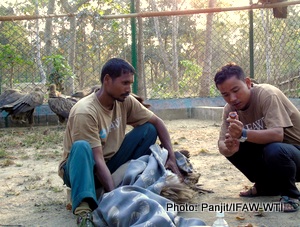To the rescue of vultures in Assam
As the first light of the sun hit the Gibbon Sanctuary in Jorhat district of Assam, Elizabeth Allgood from IFAW and I were engrossed in a discussion about the wide variety of wildlife inhabiting Assam and the rest of the North-east India.
Our conversation also focussed on the issues that plague the region and pose serious threats to the wild inhabitants of this natural hotspot.
It was January 24 and we were here to see the hoolock gibbons, but they were high up in the canopy and it was almost impossible to spot them from a distance. But, we didn’t lose hope and kept walking through this pristine landscape.
Our attention was often pleasantly diverted by the colourful butterflies that were fluttering all around us.
I was jolted out f this paradise by a frantic call from Dr. Parag of Bombay Natural History Society (BNHS) asking, “Bishwa, did you get the news?” Unaware in this paradise, I was appalled when he told me that more than 50 vultures have succumbed to poisoning in Sivasagar.
This was literally a “Black day” for the vultures in Assam.
By the time Dr. Parag disconnected the call, I had Sivasagar’s Assistant Conservator of Forests, Mr Susen Gogoi, on call waiting. After a brief chat with Gogoi about the vulture poisoning incident, I called up our rescue team and in no time the CWRC-MVS proceeded to save the birds. I joined the team with a local veterinarian, Dr. Pompi Deuri, who was eager to reach the spot and help as many birds as he can.
We reached the site during the twilight hours the same evening. The place was a mess. Forest officials along with some villagers were digging graves to bury the vulture carcases that were all spread all over.
I saw Dr. Pradip Baishya, a veterinarian from Department of Veterinary & AH, trying to revive two comatose Himalayan griffons.
Immediately, Dr. Pompi and I started to treat the last of the surviving birds. By the time we started, another vulture died. Hurriedly, I put a pipe in the lone surviving Himalayan griffon’s crop and did the crop washing. Subsequently, Dr. Pompi injected antidote and other life-saving drugs into the raptor.
Susen Gogoi, ACF, Sivasagar, was busy giving instructions to his team on burying the carcasses. He asked them to keep four of them for post-mortem. Our rescue team took the lone surviving griffon to IFAW-WTI run Centre for Wildlife Rehabilitation and Conservation (CWRC).
For the next 20 days, the vulture was looked after by the CWRC vets and the bird recovered well.
Thereafter, with a sense of satisfaction, we happily released him back into the wild following an awareness meeting called by Assam Forest Department on February 17, 2015. On that day, 51 vultures fell victims to poisoning and we could save just one. With a sense of remorse, I can say that I witnessed one of the darkest days of Assam’s conservation history.
And it just didn’t stop there. Since then, more than a hundred vultures have succumbed to reckless human behaviour. In last two months, 160 vultures were poisoned and out of them 141 died in different parts of Assam.
During this phase of rampant vulture mortalities, the IFAW-WTI run CWRC-MVS rescued 19 vultures in March, of which two Himalayan griffons were released first, followed by nine more while others are still under care and supervision of IFAW-WTI vets.
It is heartbreaking to see that people are yet to realise how this endangered bird keeps our surroundings clean and ensures that no deadly diseases are spread through rotting carcasses.
A world without vultures would be a breeding ground for disease. They deserve to be respected and conserved and protected from poisoning by people.













